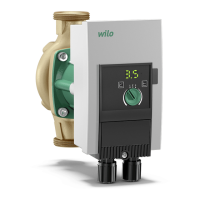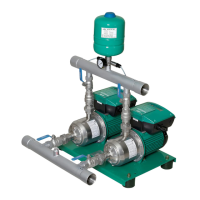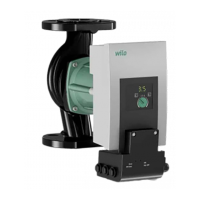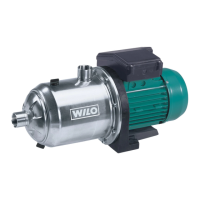Installation and operating instructions WILO Mather and Platt –MISO / PISO Pumps 17
7.2.4 Pipe work
No stress must be imposed on the pump casing by the pipe
work; neither by the weight of the pipes nor by the
tightening of badly fitting pipes (Figure 6 Pg. No.4). All
pipe worked attached to the pump must be fully supported
and the mating faces of the pipe flanges must be parallel
and all bolt holes coinciding with each other. (See table of
maximum forces on flanges) It is important, therefore, that
alignment of the pump and motor should be rechecked
after the pipes are finally fitted. Resetting or supporting
the pipes must correct any deviation in the alignment.
Avoid stress on the pump casing a: pump flange; b: pipe work
For difficult pumping on the suction side, to stabilize the
flow, a pipe length 1.5 times the diameter of the suction
branch should be installed before the suction branch.
• The flow rate in the suction line or inflow line must not
exceed 2 - 3 m/s.
• Pipe velocity may need to be reduced further to satisfy pump
NPSH requirements and to control suction pipe losses.
7.2.5 Suction line
See the sketches (refer figure 7, Pg. No.5) for the optimum
layout of pump installation for flow and suction lift operation.
Ensure that air pockets cannot be created. Unequal nominal
widths of the suction branch and suction line must be
compensated by eccentric transition pieces (refer figure 8,
Pg. No.5)
• It is recommended that a strainer is installed in front of the
suction pipe with a filter surface of at least 3 times the pipe
cross section (approx.100 meshes/cm²).
• The suction opening of the suction line should be well below
the liquid level, and a strainer should be used.
• The strainer must be far enough from the bottom to avoid
excessive inlet losses, which could impair pumping
performance. It is advisable to check that there is no leakage.
• A shut-off valve should be installed in the feed line. It must
be closed for maintenance work. It should be installed in
order to avoid air pockets forming in the spindle cap, i.e. with
the spindle in a horizontal position or pointing vertically
downward.
Layout of pump installation
1) Eccentric reducer (suction) or concentric reducer (discharge)
2) Isolating/Shut-off valve
3) Suction line
4) Bend
5) Foot valve with strainer
6) Regulating Valve
7) Pressure Point
8) Pipe Support
7.2.6 Discharge line
CAUTION! Damage to the pump
Pump casings have sometimes been cracked by pressure
surges imposed on them through the absence of a non-return
valve. A back flow can serisouly damage the bearings and the
mechanical seal.
For flow regulation, a valve must be installed behind the pump.
If non-return valves are used, they should close smoothly.
Pressure shocks must be avoided.
ENTS ON
MISO
PUMPS,
[Nm]

